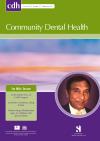Community Dental Health

- Cover Date:
- September 2011
- Print ISSN:
- 0265 539X
- Vol:
- 28
- Issue:
- 3
Relationship of caries and fluorosis in adolescents from highand low-fluoride areas in Iran
Objective: The main aim of the study was to investigate the association between water fluoride concentration and caries as well as fluorosis occurrence in adolescents in Iran. As a secondary aim we studied the relationship between caries and fluorosis occurrence. Basic research design: We examined 12-16 year-olds (n=373) in Orumiyeh [0.3 mgF-/l, low-fluoride (LF)] and Pol Dasht [3.2 mgF-/l, high-fluoride (HF)] for caries-status [D3-Level, Pitts & Fyffe (DMFS)] and fluorosis prevalence [Thylstrup & Fejerskov index (TF)]. Children completed questionnaires about several sociodemographic and oral health related factors of the previous years. To adjust for confounding, we used log risk regression and estimated relative risks (RR) and 95% confidence intervals (CI). Results: For 12-13 year-olds mean DMFS were 1.9 (sd 2.5) and 1.1 (2.2) in the LF and the HF-areas, respectively. Prevalence of aesthetically relevant fluorosis (TF>2) was 1% (LF) and 87% (HF). Water fluoride concentration (adjusted for age and SES) was inversely associated with caries-status [RR: 0.7, (CI 0.6-0.8)]. RR for fluorosis was 17 (CI 8-33). In HF-area, caries scores were significantly higher for children with TF≥5 on upper central incisors compared with TF≤4 (p<0.05 Mann-Whitney test). Conclusions: Caries prevalence in the examined areas in Iran is quite low. Aboveoptimal water fluoride concentration seems to be effective in reducing caries experience, but increases the occurrence of fluorosis. Severe fluorosis seems to be associated with higher caries occurrence in a high-fluoride area.
Key words: caries, fluorosis, water fluoridation, fluoride, Iran
- Article Price
- £15.00
- Institution Article Price
- £
- Page Start
- 248
- Page End
- 252
- Authors
- H. Meyer-Lueckel, K. Bitter, G. Khorrami, A. M. Kielbassa, S. Paris
Articles from this issue
- Title
- Pg. Start
- Pg. End
- Investing in professional advocacy: a case study of a successful fluoridation campaign in rural New South Wales, Australia
- 0
- 0
- Tooth wear and erosion: Methodological issues in epidemiological and public health research and the future research agenda
- 191
- 195
- The efficacy of dentifrices on extrinsic tooth stains among community dwelling adults in India – a randomised controlled trial
- 201
- 205
- Clinical and socio-demographic factors influencing the oral health-related quality of life of Chinese elders
- 206
- 210
- The effects of chronic pain on oral health related quality of life in patients with anterior disc displacement with reduction.
- 211
- 215
- Dental self-care and visiting behaviour in relation to social inequality in caries experience
- 216
- 221
- Clinical evaluation of chlorhexidine for the control of dental biofilm in children with special needs
- 222
- 226
- Psychometric properties of long and short forms of the Child Perceptions Questionnaire (CPQ11-14) in a Thai population
- 232
- 237
- Dental examiners consistency in applying the ICDAS criteria for a caries prevention community trial
- 238
- 242
